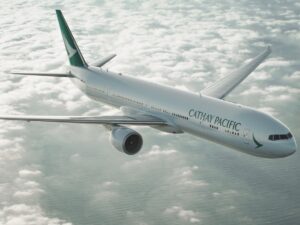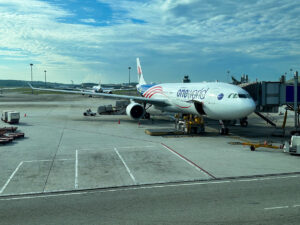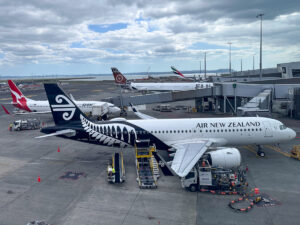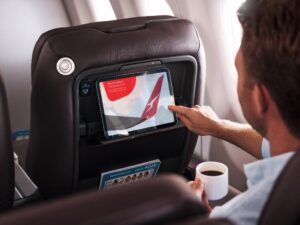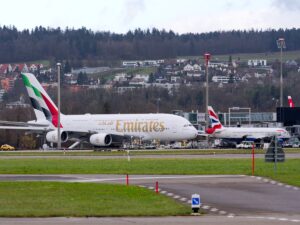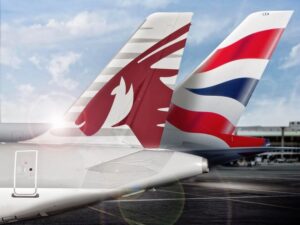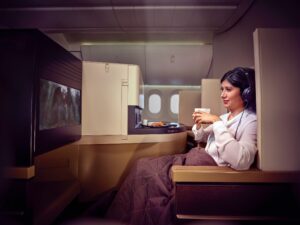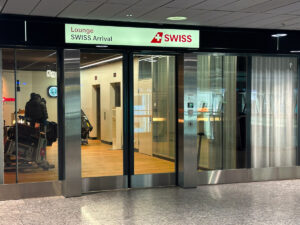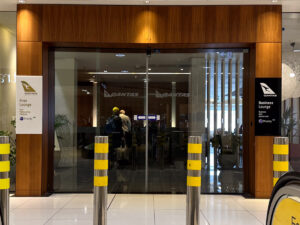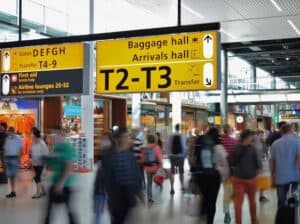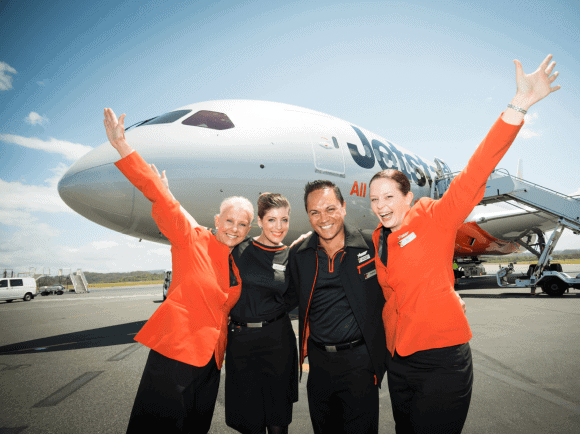
Jetstar is considering operating Boeing 787 Dreamliners on domestic routes as its Australian capacity returns to almost 100% of pre-covid levels – and even higher during peak periods.
Jetstar is already back to running an average of 70-90% of pre-covid capacity on domestic flights within Australia this month, and expects to maintain this level of flying for the rest of this year. But during peak periods such as the upcoming Easter holidays, Jetstar anticipates that its capacity could even exceed pre-covid levels.
With state borders now fully open again and demand returning, Jetstar CEO Gareth Evans told a CAPA Live event earlier this month that there’s a renewed level of optimism now in Australia. And one of the first things people want to do is visit loved ones or take a much-needed holiday.
“And what people want to do as they reclaim their lives – there’s a whole range of things they want to do – but one that’s right up there is travel. That’s got to be domestically first of all but they want to go and see their friends. They want to go and see their grandma, or their aunty, or their parents, and everybody deserves a bloody holiday right now as well,” Mr Evans said.
Jetstar has also observed that demand for flights to leisure destinations within Australia, where borders are open, is now actually higher than before.
“Where borders are open, and there are no restrictions, people are booking. It’s really strong – 10-20% above pre-covid bookings for leisure,” Evans said.
Demand for business travel has not yet returned to pre-covid levels, and may not for some time. Evans also noted that “where borders are closed or there are restrictions, bookings are zero”. But with Jetstar predominantly targeting leisure travellers anyway, this bodes well for the low-cost carrier’s business model.
Jetstar had previously hoped to be back at 80% of domestic flying last Christmas, but due to the COVID-19 outbreaks in Sydney and Melbourne – and subsequent state border closures – only managed to get to 45%. Hopefully, this time, the borders will remain open.
Load factors on Jetstar domestic flights – the percentage of seats filled by paying customers – have also been around 80% over the past few months on most routes except those still relying on Domestic Aviation Network Support funding from the federal government. Anecedontally, flights have become particularly full on many routes over the past few weeks as customers snap up ultra-competitive fares such as $29 flights from Sydney to Avalon.
As well as increasing flights on existing routes, Jetstar is now preparing to launch three new routes – and is actively looking to add more destinations in line with demand. Direct flights from Melbourne to Hamilton Island will commence next week, while Sydney-Hervey Bay starts on 26 May and Melbourne-Busselton commences on 26 June 2021.
Jetstar had previously planned to launch flights to Busselton in Western Australia’s Margaret River region in March 2020, but this launch was postponed due to COVID-19. The other routes were previously served by Virgin Australia.
Jetstar’s other new route, from Gold Coast to Hobart, already launched in December 2020.
Jetstar considers Boeing 787 domestic flights
With demand returning, especially during peak periods like school holidays, Jetstar is also considering bringing a few of its Boeing 787-8 Dreamliners out of storage to operate on domestic routes where demand is particularly high.
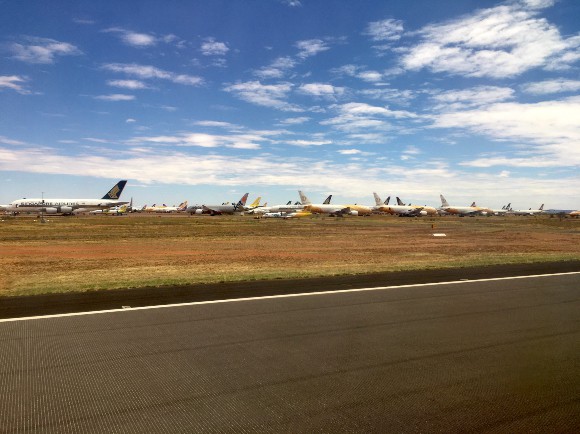
“We need more domestic lift around the peak periods, and it would be great to [use 787s] because they’re a great product. But [also] just to get some of our pilots and cabin crew associated with those aircraft flying again, it would be great to do that. So, if we do see the borders remaining open through the middle of the year, it would be great to get a couple of 787s up domestically,” Evans said.
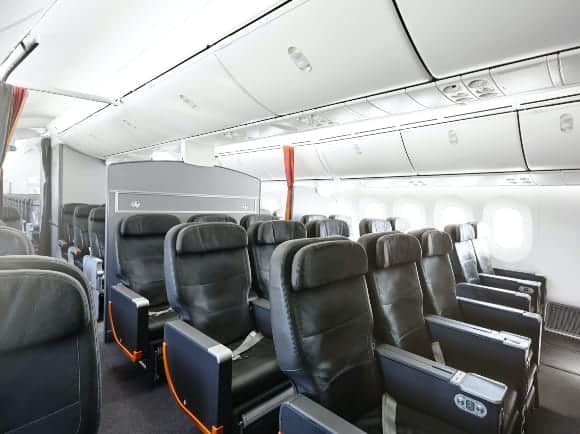
Jetstar’s recovery in Australia and New Zealand stands in contrast to the other Jetstar Group airlines, Jetstar Japan and Singapore-based Jetstar Asia, which remain highly affected by travel restrictions in those countries.
As a result, four Jetstar Asia A320s have already been sent to Western Australia to fly for Network Aviation in QantasLink colours. A further three Jetstar Japan A320s recently arrived in Australia, and three more are on the way. Some of these will be put to use as Qantas freighters and others will fly Jetstar passengers around Australia for the next 2-3 years.
Domestic demand is now back to a point that Qantas is also adding wide-body Airbus A330s to more domestic routes, including flights to Perth, Cairns and the “golden triangle” routes between Sydney, Brisbane and Melbourne. Virgin Australia even wants to lease more Boeing 737s now as well, after returning some of its planes to lessors less than a year ago.
Other Australian domestic airlines are also recovering
With borders reopened, Easter on the way, and half-price flights soon to come into the market, Qantas and Virgin are also seeing increased demand. But with those airlines relying more than Jetstar on business travellers, Qantas only expects to be operating around 80% of the number of domestic flights it would have prior to COVID-19 by Easter, and Virgin around 70%.
With international travel still off the cards for now, Qantas has been redirecting capacity that would normally be used for international routes onto domestic routes, particularly to regional and leisure destinations where demand is growing. Qantas has already launched an incredible 26 new domestic routes in Australia since the start of the pandemic including Sydney-Ballina, many regional routes and five new routes from Canberra.
Virgin Australia will also launch two new leisure routes from Melbourne to Ballina and Adelaide to Sunshine Coast next week, and Rex will be flying four new Boeing 737 routes by early April.
Domestic red-eye flights are returning
Unfortunately (or perhaps positively, depending on your point of view), the ramp-up in domestic flying will also herald the return of domestic red-eye flights. Over the past year, Australia’s airlines had a surplus of planes so didn’t need to utilise them 24 hours per day. As a result, airlines were able to schedule more flights at more convenient times for passengers.
But with more flights back in the air, and roughly the same number of planes available to operate them, airlines are now under pressure to increase their fleet utilisation again. This means the dreaded short overnight flights from Perth and Darwin to east coast destinations are back.
Jetstar has already resumed operating red-eye flights from Perth to Cairns and Gold Coast, while Virgin now has an 11.20pm departure from Perth to Brisbane and Qantas’ 11.05pm Perth-Sydney flight is back.
From next month, Jetstar will also retime its Perth-Sydney service from a leisurely 2.30pm departure to an 11.55pm service that arrives in Sydney at 6.05am the next morning. Similarly, JQ781 from Perth to Melbourne will switch from its current 5.45pm departure time to a 1.40am bleary-eyed odyssey from April. And Jetstar’s Darwin-Melbourne service will depart at 2.05am instead of 5.15pm from mid-April.
Qantas is also bringing back its 11.50pm Perth-Melbourne red-eye from next week, and from next month will switch its direct Darwin-Melbourne flight from an 11.45am departure to 1.15am. Qantas’ Darwin-Sydney red-eye departing at 1.50am will also return next month.
But the fact that demand is at least now high enough that airlines are willing to run back-of-the-clock flights is overall very good news.
Australia’s international borders may still be closed, but as long as domestic borders remain open, Australia’s airlines are on track to make a domestic comeback.
